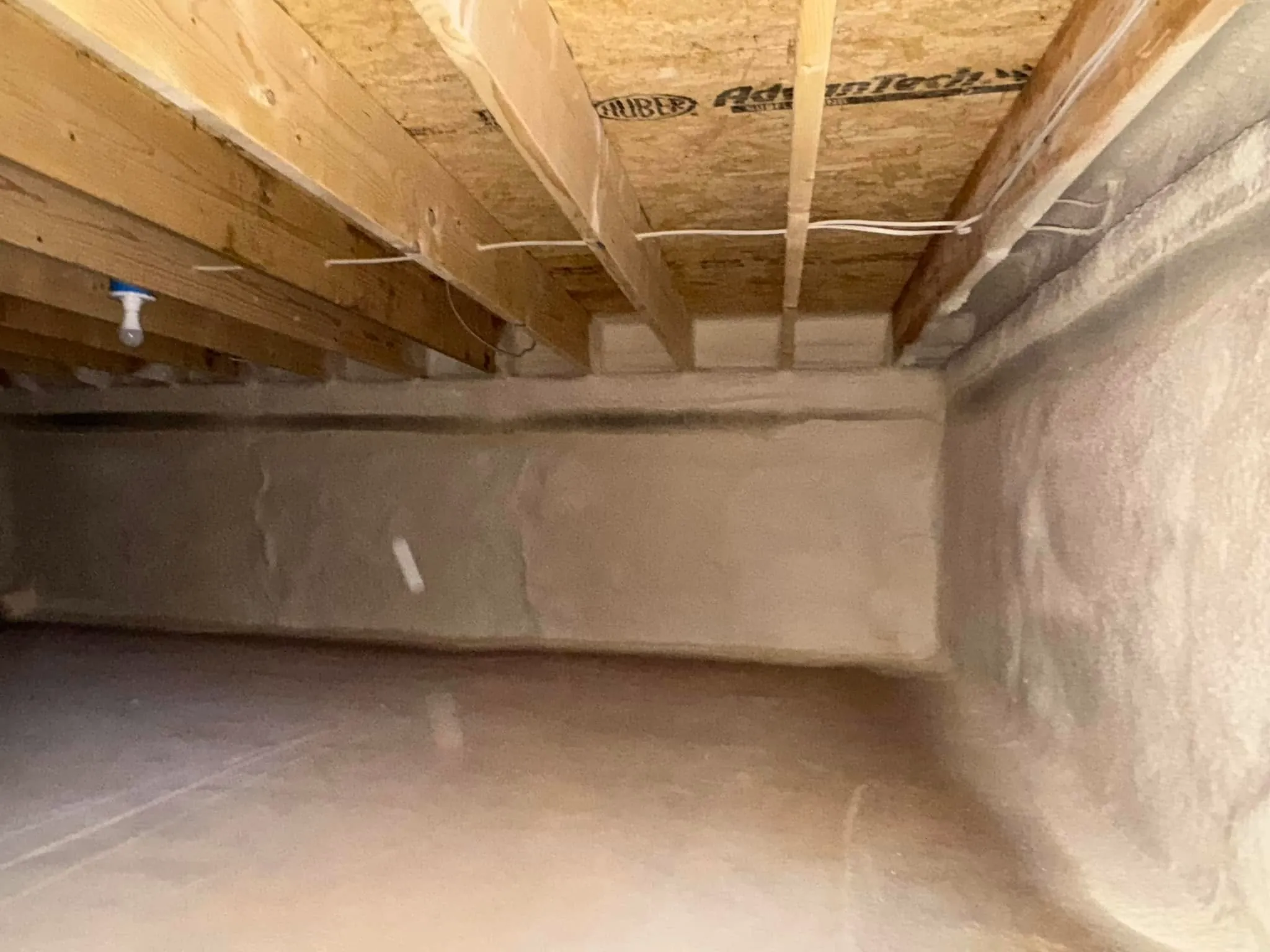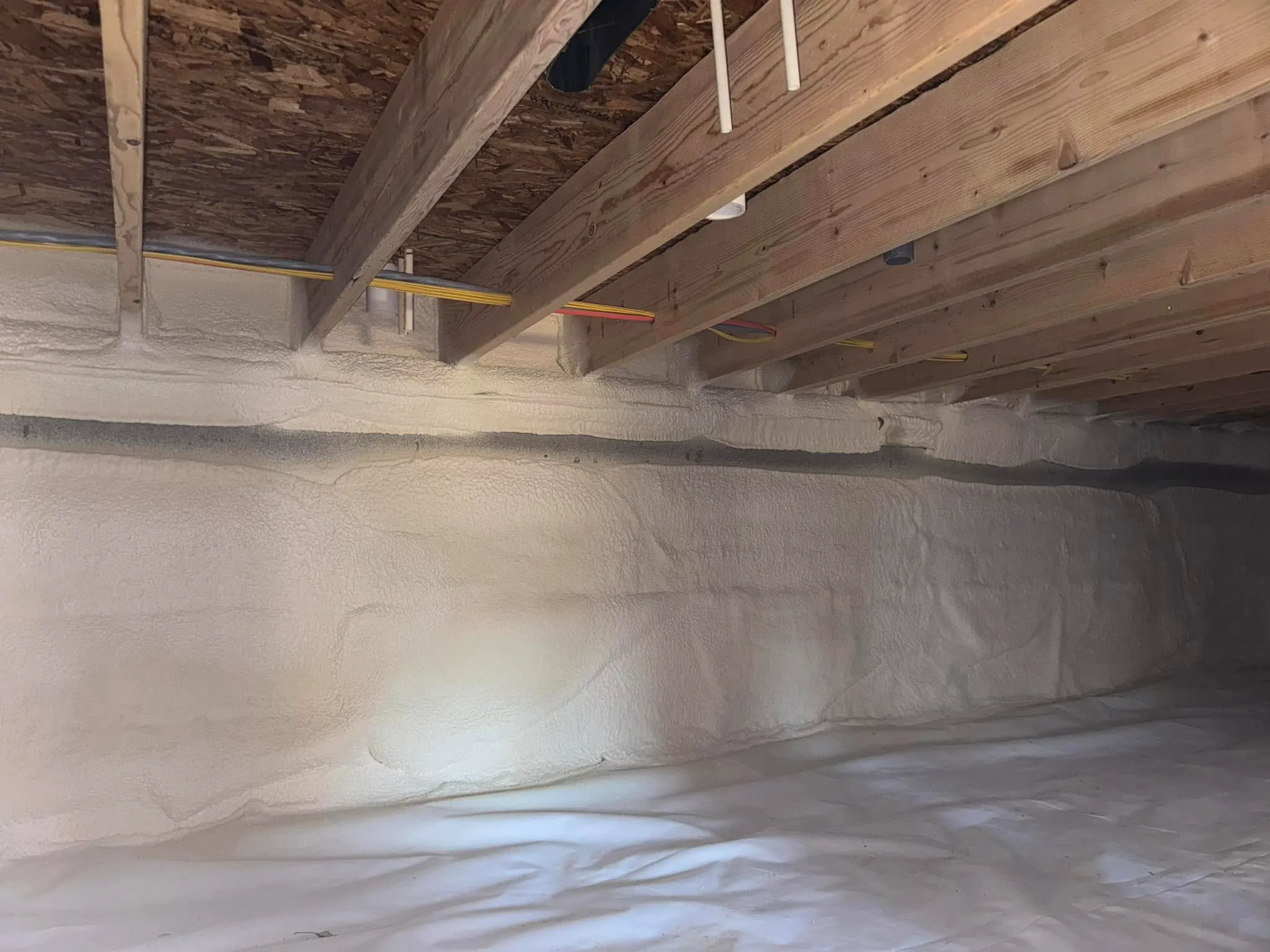
Proper crawlspace insulation prevents mold growth by controlling moisture levels and maintaining consistent temperatures throughout the space. The combination of vapor barriers, thermal insulation, and air sealing creates an environment where mold cannot establish itself, protecting both structural integrity and indoor air quality. Salisbury’s humid climate makes this protection particularly critical, as moisture accumulation in uninsulated crawlspaces creates ideal conditions for mold proliferation.
Effective mold prevention requires understanding the relationship between temperature differentials, humidity control, and proper insulation installation. Based on extensive experience with Salisbury-area homes, the right insulation strategy addresses both immediate moisture concerns and long-term environmental stability.
Mold requires three basic elements: moisture, organic material, and temperatures between 40-100°F. Crawlspaces naturally contain organic materials like wood framing and subflooring, while temperatures remain consistently within mold’s preferred range. The critical variable becomes moisture control, which proper insulation directly addresses.
Uninsulated crawlspaces in Salisbury experience significant temperature fluctuations that create condensation on cold surfaces. When warm, humid air encounters cooler foundation walls or floor joists, water droplets form and accumulate. This process intensifies during summer months when hot exterior air meets cooler underground spaces.
Bonus Tip: Check crawlspace humidity levels monthly using a digital hygrometer. Readings consistently above 60% indicate inadequate moisture control that requires immediate attention.
| Mold Growth Factors | Uninsulated Crawlspace | Properly Insulated Crawlspace |
|---|---|---|
| Temperature Stability | Fluctuates 20-30°F daily | Maintains within 5°F variation |
| Humidity Levels | Often exceeds 70% | Typically below 50% |
| Condensation Risk | High during temperature swings | Minimal with proper vapor barriers |
| Air Circulation | Poor, creates stagnant zones | Controlled with sealed environment |
Closed-cell spray foam provides superior moisture control compared to traditional insulation materials. This method creates an impermeable barrier that prevents moisture infiltration while simultaneously providing thermal protection. The foam expands to fill gaps and cracks that would otherwise allow humid air entry.
Open-cell spray foam offers moderate moisture resistance with excellent thermal properties. While more permeable than closed-cell options, proper installation with vapor barriers still provides effective mold prevention at a lower material cost.
Fiberglass insulation requires careful installation with complete vapor barrier coverage. Without proper moisture protection, fiberglass can actually worsen mold problems by absorbing and retaining moisture against organic materials.
| Insulation Performance Data | Closed-Cell Spray Foam | Open-Cell Spray Foam | Fiberglass with Vapor Barrier |
|---|---|---|---|
| R-Value per Inch | 6.0-7.0 | 3.5-4.0 | 3.1-3.4 |
| Air Permeability | 0.02 perm/inch | 8-16 perm/inch | Varies with barrier quality |
| Moisture Resistance | Excellent | Moderate with barriers | Poor without proper sealing |
| Installation Complexity | Professional required | Professional required | DIY possible with experience |
Salisbury’s location on the Delmarva Peninsula creates unique moisture challenges. The area experiences high humidity levels throughout summer months, with average relative humidity exceeding 75% during peak season. Proximity to the Chesapeake Bay and Atlantic Ocean contributes additional moisture through prevailing winds.
According to the National Weather Service, Salisbury receives approximately 45 inches of annual precipitation, with summer thunderstorms creating sudden humidity spikes. These conditions make crawlspace moisture control particularly challenging without proper insulation strategies.
Bonus Tip: Install crawlspace ventilation fans on humidity-controlled switches. Set activation at 55% relative humidity to automatically reduce moisture accumulation during peak conditions.
Winter heating cycles create additional condensation risks as indoor air temperatures rise while crawlspace surfaces remain cold. Proper insulation eliminates these temperature differentials that drive condensation formation.
Air sealing ranks as the most important aspect of mold-preventing insulation. Even minor gaps around pipes, electrical penetrations, or foundation joints allow moisture entry that undermines the entire system. Professional installation includes comprehensive sealing of all potential air pathways.
Foundation wall preparation directly impacts insulation effectiveness. Surfaces must be clean, dry, and free from existing mold growth before insulation installation. Any existing moisture problems require resolution prior to creating the sealed environment.
Ground vapor barriers complement wall insulation by preventing moisture migration from soil. Six-mil polyethylene sheeting covers the entire crawlspace floor, extending up foundation walls and sealing at all seams.
Existing moisture problems must be resolved before installing any insulation system. Standing water, persistent dampness, or visible mold growth indicates underlying issues that insulation alone cannot address. These conditions require remediation by qualified professionals before proceeding with thermal improvements.
Crawlspace access affects installation methods and long-term maintenance capabilities. Spaces with limited headroom or difficult entry points may require specific insulation approaches that accommodate these constraints while maintaining effectiveness.
HVAC system location influences insulation strategy. Ductwork, equipment, and service access requirements must be considered during planning to ensure proper system operation after insulation installation.
Building code compliance varies by jurisdiction and requires verification before beginning work. Some areas mandate specific insulation types, vapor barrier requirements, or ventilation provisions that affect material selection and installation methods.
Bonus Tip: Document existing conditions with photographs before installation begins. This record proves valuable for warranty claims, insurance documentation, and future maintenance planning.

Peninsula Insulation provides comprehensive moisture control through specialized crawlspace services.
Crawlspace Encapsulation creates completely sealed environments that eliminate moisture infiltration while providing superior thermal performance.
Closed Cell Spray Foam installation offers maximum moisture resistance with excellent insulating properties. This service addresses both thermal efficiency and mold prevention through single-application solutions.
Foundation Insulation specifically targets the thermal bridging that creates condensation conditions. Professional installation ensures complete coverage without gaps that compromise performance.
Air Sealing services complement insulation installation by eliminating the pathways that allow moisture entry. Comprehensive sealing includes all penetrations, joints, and potential air leakage points.
Musty odors, visible condensation on surfaces, rust on metal components, and wood discoloration all suggest excessive moisture levels. Professional inspection identifies specific problem areas and appropriate solutions.
Well-installed insulation systems begin controlling moisture immediately after completion. However, existing mold requires separate remediation, and full environmental stabilization typically occurs within 30-60 days.
Annual inspections verify system integrity and identify any developing issues. Properly installed systems require minimal maintenance beyond periodic vapor barrier checks and air sealing verification.
Professional installation ensures proper air sealing, vapor barrier placement, and insulation coverage that DIY approaches often miss. These details prove critical for long-term mold prevention effectiveness.
Effective crawlspace insulation prevents mold growth through comprehensive moisture control that addresses the root causes of fungal development. The combination of thermal insulation, air sealing, and vapor barriers creates stable environmental conditions that make mold growth impossible rather than simply treating symptoms.
Success requires professional installation that addresses all moisture pathways and maintains system integrity over time. Regular monitoring and appropriate maintenance ensure continued protection against mold development in Salisbury’s challenging climate conditions.
Peninsula Insulation, LLC delivers expert crawlspace moisture control solutions throughout the Salisbury region. Professional assessment identifies specific moisture sources and develops comprehensive prevention strategies tailored to local climate conditions.
Contact Peninsula Insulation at wil@mdsprayfoam.net or (410) 770-2624 for detailed evaluation of crawlspace moisture concerns. Experienced technicians provide thorough inspections and recommend appropriate insulation solutions that deliver lasting mold protection for residential and commercial properties.
Spray foam creates an airtight seal that eliminates moisture infiltration pathways while providing thermal insulation that prevents condensation. The closed-cell formula offers additional moisture resistance through its impermeable structure.
Maintaining relative humidity below 50% effectively prevents most mold growth. Properly insulated crawlspaces typically achieve 40-45% humidity levels through moisture control and temperature stabilization.
Quality spray foam insulation maintains mold-preventing properties for 20-30 years with proper installation. Vapor barriers and air sealing components may require periodic inspection and maintenance for optimal performance.
Properly installed insulation systems effectively control moisture in high-humidity environments by preventing humid air infiltration and eliminating condensation-causing temperature differentials. Regional expertise ensures appropriate material selection and installation techniques.
Proper insulation prevents new mold growth by controlling environmental conditions. However, existing mold requires separate remediation before insulation installation to ensure complete problem resolution.